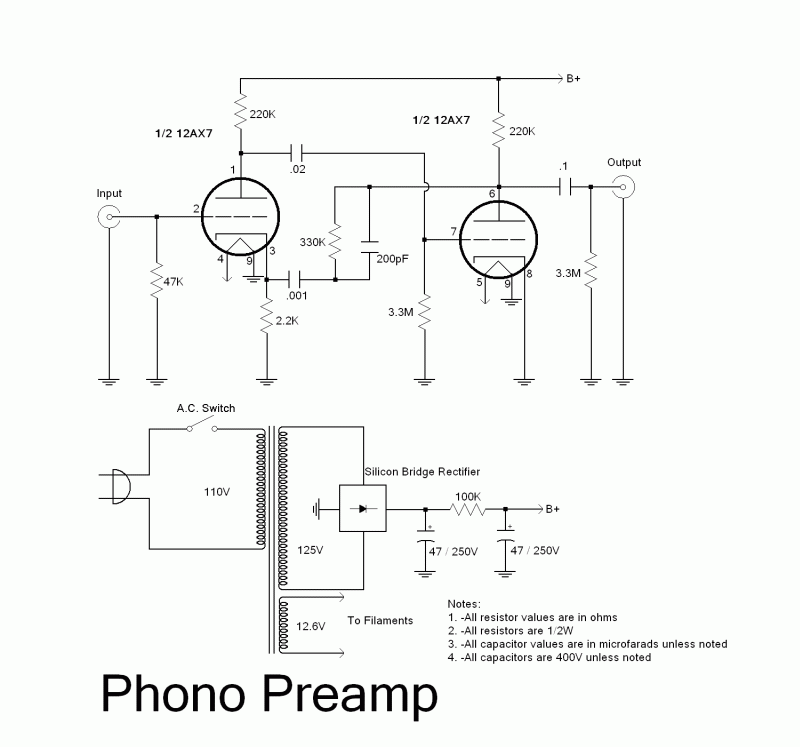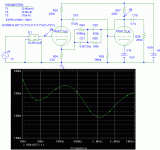
Which element in the RIAA network in the above circuit is responsible for 50Hz boost?
I've built this phono with additional cathode follower on the output, all is nice, but I feel that very low frequency could have more weight/body.
I would like to slightly modify the RIAA to make a 1-2dB bass boost.
Ps. please ignore the PSU schematic on the above picture
Which element in the RIAA network in the above circuit is responsible for 50Hz boost?
This circuit operates open loop in the lower bass, so the response is poorly defined. Use an inverse RIAA network with a signal generator to check the response. The 1nF capacitor has the most effect in the bass range, but all the RIAA components interact.
This circuit operates open loop in the lower bass, so the response is poorly defined.
Use an inverse RIAA network with a signal generator to check the response.
The 1nF capacitor has the most effect in the bass range, but all the RIAA
components interact.
Hi Rayma,
thanks for your response. Could you please share more details on what I marked "bold" above?
I need to modify this circuit manually, without inverse RIAA and signal generator, unfortunately there is no time for that.
1nf cap - rising or lowering the value should "pump up the bass"?
1nf cap - rising or lowering the value should "pump up the bass"?
The usual RIAA network over two stages would have a large resistor in parallel with the 1nF capacitor, but this style of RIAA eliminates that part, and the response at LF keeps rising until it hits the open loop curve, ideally around 50Hz, but it could vary depending on the open loop gain, which depends on the tubes.
If you want a quick and dirty method without measurements, "roughly speaking" decreasing the 1nF value will increase the response below around 500Hz, and decrease the response below 50Hz. Increasing the 1nF value will decrease the response below 500Hz and increase the response below 50Hz. A 10% change in value should make around 1dB change in response, and 20% around 2dB, and 30% around 3dB. I would suggest trying an 820pF capacitor to start with. You will be trading off the lower midrange/upper bass with the lower bass.
Last edited:
Or you could build this for much better results...
The first, second, and fourth tubes can be 6N3P or basically any other low to medium mu dual triode. Dale resistors aren't mandatory, they are labeled as such to remind me of what I used without having to look.
The 3k16 can be cheaply made from 3k3 in parallel with 100k also. Also the PS voltage can be lower... I'm using 265V in one of my builds (naked DC-DC boost module), and 330V in the other (which is using "Janus'd" ala Broskie (The Janus regulator is not, however, a DC voltage regulator, as it cannot maintain a fixed B+ voltage; instead, it works to eliminate any AC perturbations on its output voltage. In this way it is similar to a large inductor-filled power supply that bucks quick changes in output voltage, but allows slow DC voltage to vary with the wall voltage variations.) from 400V). Both of which are powered from 12V...
The first, second, and fourth tubes can be 6N3P or basically any other low to medium mu dual triode. Dale resistors aren't mandatory, they are labeled as such to remind me of what I used without having to look.
The 3k16 can be cheaply made from 3k3 in parallel with 100k also. Also the PS voltage can be lower... I'm using 265V in one of my builds (naked DC-DC boost module), and 330V in the other (which is using "Janus'd" ala Broskie (The Janus regulator is not, however, a DC voltage regulator, as it cannot maintain a fixed B+ voltage; instead, it works to eliminate any AC perturbations on its output voltage. In this way it is similar to a large inductor-filled power supply that bucks quick changes in output voltage, but allows slow DC voltage to vary with the wall voltage variations.) from 400V). Both of which are powered from 12V...
Attachments
Last edited:
The usual RIAA network over two stages would have a large resistor in parallel with the 1nF capacitor, but this style of RIAA eliminates that part, and the response at LF keeps rising until it hits the open loop curve, ideally around 50Hz, but it could vary depending on the open loop gain, which depends on the tubes.
If you want a quick and dirty method without measurements, "roughly speaking" decreasing the 1nF value will increase the response below around 500Hz, and decrease the response below 50Hz. Increasing the 1nF value will decrease the response below 500Hz and increase the response below 50Hz. A 10% change in value should make around 1dB change in response, and 20% around 2dB, and 30% around 3dB. I would suggest trying an 820pF capacitor to start with. You will be trading off the lower midrange/upper bass with the lower bass.
Today I have tried with 1270pf capacitors and now need to find a 800-900pf pair. It's hard for me to estimate which frequencies increased and which one decreased, but I think I need to bump the 100-200Hz range. My speakers have -3dB on 34Hz (Jamboree style horns) therefore I think I dont fight for the 50Hz region.
With 1270pf it's still not exactly the effect I wanted, but I need to say that bass started to be bloomy. Maybe the effect I notice is actually the sound of 12AX7. I am used to phono preamps with low RP tubes and very low output impedance, usually these are very detailed and direct sounding preamps. I wanted to build something more forgiving so I've chosen 12AX7 as this seems to be classical choice for phono.
Well, I will still fight with this preamp and search 800-900pf caps. Will keep thread updated.
Today I have tried with 1270pf capacitors and now need to find a 800-900pf pair.
You can parallel several smaller caps to total around 800pF. I suspect you'll prefer
smaller than 1nF, rather than larger than 1nF, if you are looking for a "fuller" sound.
> Which element in the RIAA network in the above circuit is responsible for 50Hz boost?
As said: tube gain compared to NFB/EQ gain.
The 1KHz gain is approximately 330k/2.2k, or 150, or VERY HIGH.
The <100Hz gain should be 20dB more, 1,500. This is perhaps in sight of what two 12AX7 can do. Actually with 2.2k under the first, we get gain of 2,100. This means that *very* slight change of 12AX7 gain (tubes, or supply voltage) will cause significant change in the low frequency gain/EQ.
These values (below) simulate as +/-0.2dB over the audio band. I do have doubt any real tube build can be that exact.
E1 is a math-exact rev-RIAA source. V10 is a dummy bias because my tube models do not grid-leak bias like a real 12AX7 will. As Rayma says, you can make-up the odd values from several parts.
As said: tube gain compared to NFB/EQ gain.
The 1KHz gain is approximately 330k/2.2k, or 150, or VERY HIGH.
The <100Hz gain should be 20dB more, 1,500. This is perhaps in sight of what two 12AX7 can do. Actually with 2.2k under the first, we get gain of 2,100. This means that *very* slight change of 12AX7 gain (tubes, or supply voltage) will cause significant change in the low frequency gain/EQ.
These values (below) simulate as +/-0.2dB over the audio band. I do have doubt any real tube build can be that exact.
E1 is a math-exact rev-RIAA source. V10 is a dummy bias because my tube models do not grid-leak bias like a real 12AX7 will. As Rayma says, you can make-up the odd values from several parts.
Attachments
Last edited:
> Which element in the RIAA network in the above circuit is responsible for 50Hz boost?
As said: tube gain compared to NFB/EQ gain.
The 1KHz gain is approximately 330k/2.2k, or 150, or VERY HIGH.
The <100Hz gain should be 20dB more, 1,500. This is perhaps in sight of what two 12AX7 can do. Actually with 2.2k under the first, we get gain of 2,100. This means that *very* slight change of 12AX7 gain (tubes, or supply voltage) will cause significant change in the low frequency gain/EQ.
These values (below) simulate as +/-0.2dB over the audio band. I do have doubt any real tube build can be that exact.
E1 is a math-exact rev-RIAA source. V10 is a dummy bias because my tube models do not grid-leak bias like a real 12AX7 will. As Rayma says, you can make-up the odd values from several parts.
Thank you for informative response.
Well, honestly I thought that slight different in plate and cathode resistance will not make a huge difference in RIAA EQ, and from what I remember my plate resistors are 210K in first stage and 230k in second stage, it can be same with cathode resistor in first stage. I am pretty sure I've got like 5% difference in values VS the schematic.
150 voltage gain on 1khz is 43dB which from I've found in the internet (RIAA: 60 dB at low frequencies, 40 dB at 1000 Hz, and 20 dB at high frequencies. ) is pretty much OK I guess.
How did you calculated 2100gain on <100Hz? It's 66dB, so 23dB more than 1Hz. I might be fooled by my audio system, but I dont hear low frequencies so loud for sure.
Later I will measure precisely anode and cathode resistors in my circuit to find super precise values.
...I thought that slight different in plate and cathode resistance will not make a huge difference....
I don't think I said they would?
The 220k is in parallel with tube internal resistance, nominally 60k, but +/-20%, so really 48k-72k, 39k-54k node impedance. 5% variation in plate load resistor is not as important as tube variations.
Most of the effect is in the range where the "4.5Meg" dominates. Make this 3.9Meg plus 1Meg trim-pot. Use proper test gear and trim for best EQ.
- Status
- This old topic is closed. If you want to reopen this topic, contact a moderator using the "Report Post" button.
- Home
- Amplifiers
- Tubes / Valves
- simple phono preamp - bass boost

